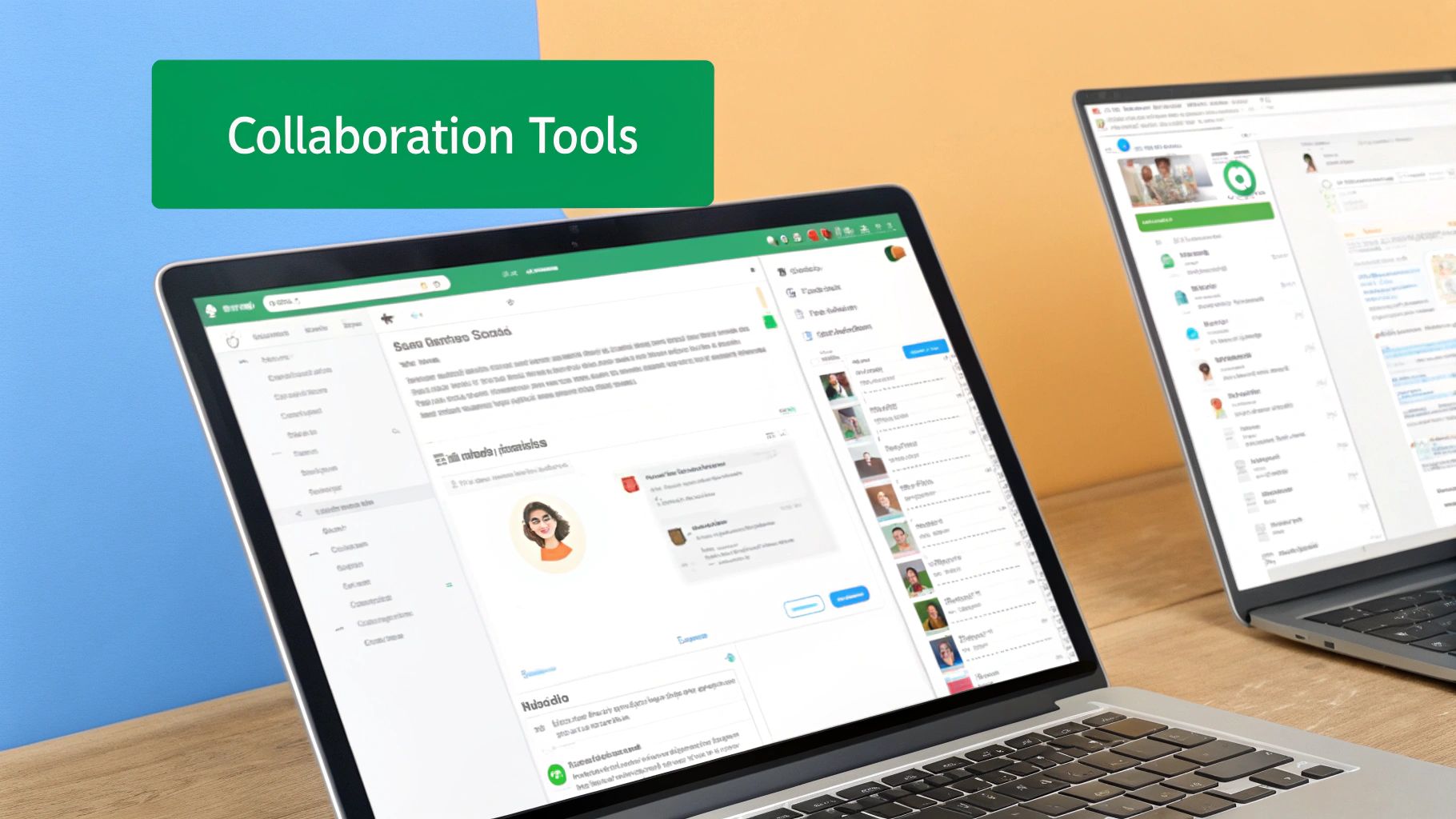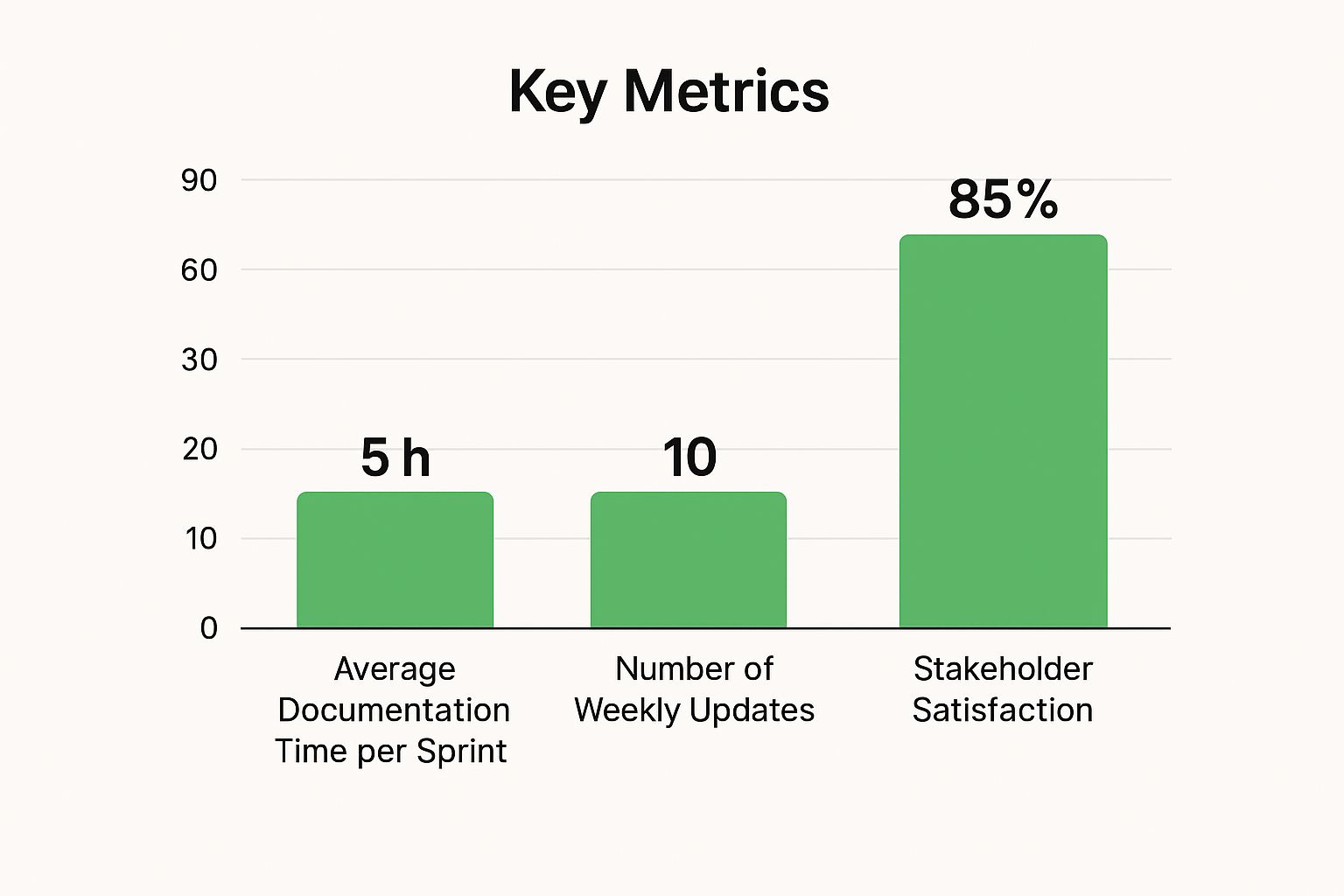Master agile software development documentation with proven strategies from successful teams. Practical tips for efficient docs that support rapid delivery.

Let’s be honest: lengthy documentation often gathers dust in agile software development. This happens because traditional documentation, designed for waterfall methodologies, clashes with Agile’s flexible and fast-paced nature. Traditional methods prioritize extensive upfront documentation, creating a rigid structure that struggles to adapt to inevitable changes. This often leads to wasted time documenting features that are later modified or even abandoned as the project progresses.
Agile documentation, on the other hand, thrives on being lean and adaptable. Documentation is created “just-in-time,” focusing on what’s immediately needed for the current sprint or iteration.
For instance, instead of a comprehensive system design document at the start, an agile team might create user stories, acceptance criteria, and concise technical specifications for the current sprint’s features. This allows the documentation to evolve alongside the product, ensuring it stays relevant and accurate. Agile documentation faces unique challenges due to Agile’s core principles of flexibility and rapid iteration. Unlike traditional waterfall methods, Agile promotes lightweight, just-in-time documentation.
A 2023 analysis shows that teams often struggle to find the right balance between detail and speed. Learn more about documentation in agile challenges and trends in 2023 here.
Traditional documentation methods create several obstacles for agile teams. These obstacles can slow development and hinder the team’s ability to respond effectively to changes.
Successful agile teams use a “just enough” documentation approach. This approach focuses on documentation that serves a clear purpose and adds value. It minimizes waste by concentrating on essential information.
Read more about finding this balance in How to master the documentation balancing act in agile development. This streamlined approach reduces the maintenance burden and helps keep documentation relevant throughout the project’s lifecycle. By prioritizing value and minimizing overhead, agile teams ensure documentation supports, rather than hinders, development.

Agile methodologies have profoundly changed software development. Teams now face the challenge of balancing speed with comprehensive documentation. Understanding current Agile adoption trends is key to building a successful documentation strategy. Many organizations are still learning how to seamlessly integrate documentation into their Agile workflows.
This shift requires a fresh perspective on how we approach documenting software projects.
Agile emphasizes working software over extensive documentation. This principle is sometimes misinterpreted as meaning documentation is unimportant in Agile. The reality is that Agile promotes a different approach, focusing on creating just enough documentation. This “just enough” philosophy ensures teams have the information they need without getting bogged down in unnecessary paperwork.
The 17th Annual State of Agile Report (2024) reveals that roughly 71% of software development teams worldwide now use Agile. Engineering and R&D teams comprise 48% of Agile users, a 16% jump since 2022. This shows a growing trend towards Agile in technical fields. You can find more detailed statistics here. This growth highlights the importance of documentation practices that fit with Agile principles.
Integrating documentation into Agile requires a change in mindset and working practices. Teams should adopt living documents that evolve alongside the product, moving away from static, unchanging documentation. This involves cultivating a culture of continuous documentation. Updates are made incrementally throughout the development process.
Effective Agile documentation utilizes collaborative tools and workflows like Confluence or Notion. This ensures everyone understands and takes ownership of the documentation. This collaborative approach makes documentation a valuable asset, supporting the iterative and collaborative nature of Agile.

As Agile software development took hold, documentation practices changed significantly. The era of extensive upfront documentation gradually shifted towards a more dynamic and iterative approach, reflecting Agile’s core values of flexibility and rapid iteration. This transition wasn’t always easy, and many teams struggled to adapt.
However, by focusing on the value of documentation rather than the volume, successful teams transformed documentation from a burden into a valuable asset. This involved a fundamental change in mindset. Instead of documenting every single detail, teams became more strategic.
They focused on documentation that served a clear purpose. For example, user stories and acceptance criteria became essential, offering clear direction for development and testing. This targeted approach reduced the overall amount of documentation while increasing its relevance and usefulness.
The rise in Agile adoption played a key role in this shift. Agile adoption among developers jumped from 37% to 86% over five years (2019-2024), indicating a major change in software delivery models. Teams now prioritize creating documentation that evolves with the product. Learn more about these statistics at Esparkinfo. This prioritizes clarity, relevance, and accessibility for everyone involved.
One of the biggest changes was the move from static documents to living documents. Static documents, common in waterfall methodologies, quickly become outdated in Agile’s fast-paced environment. Living documents, however, evolve alongside the product.
They are regularly updated, ensuring the information stays current and relevant. This requires collaborative tools and a shared sense of responsibility within the team. This ensures everyone has access to the most up-to-date information.
A common concern about reducing documentation is the potential loss of valuable knowledge. However, successful Agile teams found ways to maintain knowledge sharing without being overwhelmed by maintenance. Tools like wikis and internal knowledge bases became crucial.
These tools provide a central repository for information that the entire team can easily access and update. This collaborative approach allows for efficient knowledge management without sacrificing development speed.
The evolution of Agile software development documentation involved a process of trial and error. Many practices that seemed promising initially didn’t work out in the long term. What ultimately emerged was a set of core principles and practices focused on delivering value.
This means supporting the rapid pace of Agile development by striking a balance between sufficient documentation and avoiding unnecessary overhead. This balance allows teams to document their work effectively without slowing down the development process. This iterative approach ensures that documentation remains a valuable asset throughout the project lifecycle.

The infographic above offers a compelling comparison of different documentation approaches. It analyzes average documentation time per sprint, the number of weekly updates, and overall stakeholder satisfaction. Clearly, focusing on the right documentation types yields substantial improvements. You’ll see gains in both efficiency and stakeholder buy-in. Specifically, prioritizing living documents, actively maintained by the team, leads to higher stakeholder satisfaction, more frequent updates, and a reduction in time spent on documentation during each sprint. Let’s delve deeper into these high-value documentation types in Agile.
Instead of generating documentation that sits unused, concentrate on types that actively contribute to the Agile software development process. These living documents are regularly updated and referenced, making them invaluable resources. They seamlessly support the rapid development cycles inherent in Agile by providing precisely the right amount of information at the right time.
To better understand the practical application of these document types, let’s examine their core values and best practices. The following table summarizes the key aspects of each.
High-Value Agile Documentation Types: Analysis of documentation types that successful agile teams actually maintain and use, with practical guidance on implementation and maintenance
This table summarizes the core benefits and maintenance requirements of each documentation type, helping teams choose the right approach for their needs. Prioritizing these living documents empowers Agile teams to stay aligned and informed throughout the project lifecycle.
Creating effective documentation involves more than just selecting the correct type. Here are some techniques to ensure your documentation is both valuable and usable.
These practical strategies ensure your Agile documentation supports, rather than hinders, your team’s progress. By focusing on value, conciseness, and collaboration, your documentation transforms into a dynamic asset, not a static burden. The key takeaway is to create documentation that is actively used, contributing to the team’s shared understanding and overall project efficiency.
Keeping agile software development documentation current can feel like a never-ending struggle. However, the right automation tools can significantly lessen this burden without creating new problems. The key is selecting tools that integrate smoothly with your existing processes, rather than forcing your team to adapt to the tool.
A well-structured project documentation template is helpful for guiding the creation of documentation that actually gets used in agile development. This helps align the automated output with the information your team truly needs. Evaluating automation solutions based on your team’s real-world workflow, not just marketing promises, is essential. Consider factors such as:
Several types of tools can effectively automate various aspects of agile software development documentation. Let’s explore some of the most impactful categories:
To help you choose the best fit for your team, the following table compares several popular documentation automation tools:
Introducing a comparison of documentation automation tools that deliver tangible results. This table analyzes how these tools can effectively reduce documentation overhead while boosting accuracy and team adoption in real-world scenarios.
As you can see, different tools offer varying benefits and integration complexities. Choosing the right tool depends on your specific needs and team structure.
Successfully incorporating automation requires careful planning and execution. Consider the following best practices:
By focusing on the appropriate tools and integration techniques, automation can become a valuable asset in your pursuit of efficient and effective agile software development documentation. This frees up valuable time for your team to concentrate on what matters most: developing excellent software.
Creating documentation habits that teams genuinely embrace, without requiring constant supervision, involves a shift in mindset. Instead of seeing documentation as a tedious task, teams need to recognize its inherent value. This section explores practical strategies for making agile software development documentation a valuable asset, rather than a dreaded chore.
Begin by setting clear documentation standards. This might include creating templates for frequently used document types, such as user stories, acceptance criteria, and architectural decision records. Templates promote consistency and reduce the mental effort required from contributors.
In addition to establishing templates, encourage collaborative creation. When teams take ownership of the documentation process, they become more inclined to actively use and maintain it.
For instance, holding regular documentation workshops can transform what often feels like an isolated task into a shared activity. This fosters a sense of ownership and ensures the documentation accurately reflects the team’s collective knowledge. This shared responsibility is crucial for creating agile software development documentation that stays relevant and useful. You might be interested in: How to master agile development documentation.
Implement streamlined review processes that align with the Agile methodology. Instead of time-consuming formal reviews, opt for quick peer reviews or asynchronous feedback using collaborative platforms. This keeps the documentation flowing smoothly without compromising quality.
This efficient approach ensures documentation stays up-to-date in a fast-paced development setting. Tools like GitHub and Google Docs facilitate asynchronous reviews, allowing team members to provide feedback conveniently.
Go beyond simply verifying whether documentation exists. Focus on determining its actual usefulness. Actively solicit feedback from the team on how they utilize the documentation and what improvements they recommend.
Track usage patterns to identify which documents are frequently accessed and which are neglected. This data-driven approach highlights what’s working effectively and where adjustments are necessary. Just as AI-Powered Advertising uses data to enhance marketing strategies, analyzing documentation effectiveness can significantly improve its value to the team.
Documentation is essential for knowledge transfer and onboarding new team members. Maintain a centralized, easily accessible repository for all project documentation. This enables new members to quickly integrate into the team and reduces reliance on specific individuals for information.
As the team expands, maintaining consistent documentation practices becomes even more vital. Ensure that documentation standards are clearly communicated to all new hires. This helps prevent information silos and streamlines the onboarding process. Consider appointing a “documentation champion” within the team to promote best practices and address any questions.
By concentrating on these key areas, you can establish documentation practices that are sustainable and effectively support your Agile software development process. This transforms documentation from a perceived burden into a powerful resource that empowers your team and adds value at every stage of development.